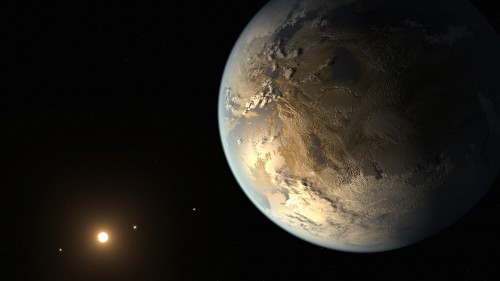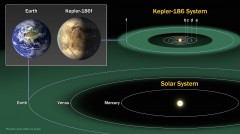
Today was another big day for those interested in space exploration and in the search for other Earth-like, alien worlds in particular: The first Earth-sized exoplanet orbiting another star in the habitable zone has been discovered, it was announced by astronomers with the Kepler space telescope mission.
The planet, Kepler-186f, is one of five known planets in the Kepler-186 system, which is about 500 light-years away in the constellation Cygnus. The star is a red dwarf and is half the size and mass of our own Sun. The discovery is highly significant and important for some obvious reasons.
As Paul Hertz, director of NASA’s Astrophysics Division in Washington, noted: “The discovery of Kepler-186f is a significant step toward finding worlds like our planet Earth. Future NASA missions, like the Transiting Exoplanet Survey Satellite and the James Webb Space Telescope, will discover the nearest rocky exoplanets and determine their composition and atmospheric conditions, continuing humankind’s quest to find truly Earth-like worlds.”
Kepler-186f is only about 10 percent larger than Earth, so it is thought to be a rocky world like ours, although the mass and composition are not yet known. Other exoplanets have previously been found in the habitable zone of their stars as well (where temperatures can allow liquid water to exist), but the smallest so far were still about 40 percent larger than Earth. Kepler-186f is the first one to be categorized as truly Earth-sized. Also, other exoplanets of similar size or even smaller have started to be found, but not in the habitable zones of their stars. Kepler-186f is the first to be both Earth-sized and in the habitable zone, the ideal combination.

Even though Kepler-186f orbits closer to its star than Earth—in 130 days—the planet is not scorching hot like Mercury because the star itself is smaller and dimmer than our Sun. Such stars have smaller habitable zones, but Kepler-186f is situated nicely within it. All of the other four exoplanets, however, are much closer to the star, with orbits of four, seven, 13, and 22 days. They are all less than 1.5 times the size of Earth. These red dwarf-type stars are also the most common in the galaxy, making up about 70 percent of the stellar population.
As a rocky planet in the habitable zone, the planet could have liquid water on its surface, but not enough is known yet to determine that. What the discovery does show, however, is that Earth-sized exoplanets can and do exist in the habitable zones of other stars, an exciting discovery with implications for extraterrestrial life:
“We know of just one planet where life exists – Earth. When we search for life outside our solar system we focus on finding planets with characteristics that mimic that of Earth,” said Elisa Quintana, research scientist at the SETI Institute at NASA’s Ames Research Center. “Finding a habitable zone planet comparable to Earth in size is a major step forward.” She is also the lead author of the new paper just published in Science.
In terms of Kepler-186f actually being inhabited by any kind of life, it is much too early to say. As Thomas Barclay, a research scientist at the Bay Area Environmental Research Institute at Ames, and co-author of the paper, explained: “Being in the habitable zone does not mean we know this planet is habitable. The temperature on the planet is strongly dependent on what kind of atmosphere the planet has. Kepler-186f can be thought of as an Earth-cousin rather than an Earth-twin. It has many properties that resemble Earth.”
The discovery does bring us one big step closer, however, to finding another planet similar to our own and perhaps many more where life has taken hold, an exciting possibility indeed.
Want to keep up-to-date with all things space? Be sure to “Like” AmericaSpace on Facebook and follow us on Twitter:@AmericaSpace




Very nice article and discovery but….At 500 light years away not much chance of us ever getting there anytime soon….The Alpha Centauri system is only 4.24 light years away and I am thinking that is where we should be looking…
Closer and closer to the inevitable discovery of life beyond Earth! It will happen soon.
Exactly right Tom, and I for one (and I’m sure our friend Leonidas will join me) would love to see the population of this mote of dust in the unfathomably enormous cosmos jolted into the necessity of facing fundamental issues of our existence in the universe. How many times have those of us with IQs greater than room temperature gazed into a star-filled night sky and wondered, “When?”. If only to live long enough to hear that celestial “Hello, is anyone out there?” or to see proof of life, any life, out there. The cosmos is either teeming with life . . . or we are all alone in the vast cold of space. In either event, the implications are indeed awesome. When life is eventually discovered, what will probably happen? Media fixation on what a Justin Bieber, Miley Cyrus, or Lindsay Lohan did at a nightclub. Where the Hell’s my Cutty Sark . . .
I can only concur with your comments Tom and Karol. This is an epic discovery, pure and simple, without any hype. The feeling of acknowledging the fact that Earth-analog terrestrial exoplanets exist in the vast expanses of the Milky Way, makes my neurons fire up with awe and wonder.
This discovery brings a recent wonderful video tribute to the ‘Pale Blue Dot’ audiobook in mind, which Carl Sagan had recorded back in 1994, which I feel inclined to share with you.
http://www.youtube.com/watch?v=z-6wXZXOUV8
Getting a probe to Centauri is probably beyond our lifetimes. Still these discoveries are cool. We still have to be careful about seeing things in data that aren’t there.
Mercury, venus, mars and numerous moons are within a life time range.
A launch site on mars could reach LEO easier than one on earth.